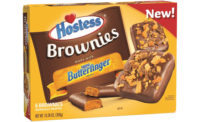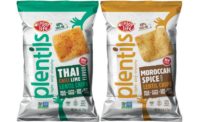Retail Product Trends Annual | Bakery Foods
2017 Bakery Trends: Flavor and Function
New bakery foods products push both indulgence and health






Bakery food innovation in 2016 was a study in opposites with new product action focused at two extremes. There are indulgent products focused on taste as well as and healthful products with added functionality or fewer objectionable ingredients.
On the indulgence front, bakery food makers went after snacking. This could grow usage occasions while capitalizing on novelty-seeking behavior, which is higher for snacks than for other food types. According to a third-quarter 2016 survey by GlobalData (formerly Canadean), 31% of US consumers say they “often” try new and different varieties of snacks, much higher than the 21% that say they do the same for cakes and pastries.
Tradition often dictates when specific cakes or pastries tend to be consumed. Italian rainbow cake, for instance, tends to be popular around the holidays. Cookies United broke from that tradition in 2016, turning Italian rainbow cake into an everyday snack with The Original CakeBites Classic Italian Rainbow. Packaged like a candy bar, each wrapper holds three individual cake bites.
Baked goods often taste best warm. Extending this benefit to a packaged product can be challenging, but Cinnabon Gooey Bites Warm Cinnamon Treat rose to the challenge in 2016. This shelf-stable product came packed in a disposable, no-mess bowl that is warmed in the microwave oven for 20 seconds, yielding a warm, gooey treat.
Speaking of warmth, toaster pastries saw a burst of flavor innovation in 2016 from new sources, like soft drinks. Kellogg added Crush Orange and A&W Root Beer flavors to its Pop-Tarts line. Pop-Tarts also capitalized on the love of all things bacon with a Frosted Maple Bacon flavor featuring “bacon-y sprinkles.”
The “pumpkin spice effect” has made bread and roll makers more open to seasonal flavors outside of fall and winter. Bimbo Bakeries USA’s rolled out a Salted Caramel flavor of its Thomas’ English Muffins and Bagels during the summer months. The “limited edition” flavor tapped the sweet and salty flavor trend.
“Artisan” offerings were trendy for bread and baked goods. Trader Joe’s went this route with Artisan Bread Pretzel Croissants “made by scratch from experienced craftspeople.” So did Panera Bread, which went retail with Panera Bread Artisan Frozen Bread, said to deliver “fresh from the bakery taste” at home. According to Panera, the brand hit more than 12,000 retail locations, with plans for further expansion.
Specialty food-inspired flavors can help a brand make a case for “artisan.” Asiago cheese helped close the deal for Pepperidge Farm’s new cheese bread line with “restaurant-inspired cheese flavors” to make an ordinary sandwich extraordinary.
The other big trend in baked goods in 2016 was enhanced health including many made without any wheat or grains. Americans remain wary of gluten, with 36% saying they are either trying to avoid or limit intake of gluten, according to a third-quarter 2016 survey from GlobalData. Forty-three percent say they are trying to do the same for carbohydrates.
These avoidance behaviors—combined with the continued popularity of the paleo diet (which preaches avoidance of grains)—paved the way for innovations like Siete Grain-Free Cassava & Coconut Tortillas. These refrigerated wraps were free of wheat, corn, rice, eggs, soy, and dairy ingredients. Pure Wraps Coconut Wrap struck the same notes, made with just three ingredients: coconut meat, coconut milk, and Himalayan salt. These wraps avoid the top eight food allergens, including tree nuts, wheat, corn, dairy, and soy.
Another way to address avoidance behavior is to reduce portion sizes. Kontos Cocktail Flatbread did that with bite-size pieces of flatbread sized right for appetizers, dips, or mini sliders. Yet another approach is to use ingredients perceived to be “better for you.” Chickpeas fit the bill as they are naturally high in protein and fiber. Watusee Foods Chickpea Crumbs offered a gluten-free panko breadcrumb replacement. Soy protein isolate drove the protein content for Tumaro’s Premium White Protein Wraps to 9g per serving.
Protein continues to resonate with consumers. Thirty-eight percent of Americans said they try to consume as much protein as possible, according to a third-quarter 2016 GlobalData survey. That’s higher than the 32% that said the same about fiber, and 29% for whole grains.
Outside of the trend toward thinner cookies, most of the new product innovation in cookies revolved around indulgent flavors.
The thin cookie trend received a vote of confidence from Mondelez Global in 2016 which extended it to its Chips Ahoy! brand. Chips Ahoy! Thins had just 150 calories in four “thin & crispy” Cinnamon Sugar cookies. Mondelez extended its Nabisco Oreo Thins line with a Lemon Flavor Crème variant while Kellogg’s Keebler brand joined in with Simply Made Cookie Thins.
Back to Nature’s SnackWell’s brand used the thin cookie concept to go after breakfast with Biscuit Thins – a high protein and fiber cookie “made with real coffee” in flavors like Caramel Macchiato. The breakfast opportunity was an obvious target for Mrs. Thinster’s Waffle Crisps, a new thin and crispy “waffle” type cookie in flavors like Blueberry and Maple Syrup.
The most interesting thin cookie of 2016 may have been Sugar Bowl Bakery’s Batter Crisps Cookie Crisps, a “melty, buttery, crispy” cookie identified as “edible cake batter in cookie form.” The launch sought to capture the “bowl-licking joy of cake batter.”
Cookie flavor innovation was heavy in 2016 with candy flavors providing inspiration. Mondelez Global continued to play the limited-time flavor game with Nabisco Oreo cookies, adding its oddest flavor yet with Swedish Fish – inspired by the gummy candy. The flavor was only sold at Kroger stores, for a limited time. Strawberry Shortcake, Filled Cupcake, and Blueberry Pie were more conventional limited time flavor additions for Oreo in 2016.
Candy-inspired innovation also came from Jelly Belly Frosted Sugar Cookies made by Lofthouse. Featuring frostings inspired by three of the top selling classic Jelly Belly flavors (Berry Blue, Very Cherry, and Lemon Lime); these cookies were hard to miss with their bright neon colors. Similar bright colors were the calling card for Pillsbury Ready to Bake! Dreamworks Trolls Cutout Sugar Cookies.
One newer source of cookie innovation was online snack companies like NatureBox which expanded into brick-and-mortar stores in 2016. The company launched eight snack products “made with simple ingredients” like Mini Belgian Waffle Cookies into Target stores during the year.
Another newcomer to watch was Hampton Creek, a company known for its egg-free Just Mayo. Eager to expand beyond mayonnaise, the San Francisco-based company rolled out more than 40 new products in 2016 including Just Cookies in Chocolate Hazelnut and Peanut Butter flavors, both with sorghum flour as an ingredient.
Other ingredient trends to watch included the use of almond flour for Jimmy’s Cookies’ new Paleo Cookies in flavors like Chocolate Chunk. These frozen cookies have no grains and no gluten. Stevia is well established in beverages, but is more of a rarity in cookies. iBake Foods attempted to change that with iBake White Frosted Sugar Cookies made with stevia so they have “49% less sugar.”
Functional cookies were scarce in 2016, with a couple of exceptions. Get Up And Go Smart Energy Cookie in flavors like Chocolate Chip was pitched as an edible alternative to energy drinks or coffee with 180mg of caffeine per 3oz cookie. LesserEvil Good Cookie lived up to its name with 494mg of omega-3’s from nuts and seeds in each three cookie serving plus one billion CFU probiotics. LesserEvil says the cookies are for “mindful eaters.”
Cracker innovation was robust in 2016. Strong new product activity is one reason that GlobalData projects that crackers (savory biscuits) will grow at a 1.8% compound annual growth rate (CAGR) in the US for the period from 2015 to 2020. That exceeds the 1.6% CAGR projected for cookies (sweet biscuits) over the same period.
Like many baked goods, crackers are entertaining ingredient options outside of corn and wheat. Almond flour is one to watch, headlined by the 2016 debut of Simple Mills Almond Flour Crackers, made with a proprietary flour blend made from almonds, sunflower seeds, and flax seeds. The blend is gluten free and protein-rich. Simple Mills’ Farmhouse Cheddar Crackers deliver 3g of protein per serving.
Chickpeas and sweet potatoes are other iconic health ingredients with potential in crackers. Mondelez Global was bullish on these alternatives plus rice, making them signature ingredients for its new Nabisco Good Thins cracker line. The brand was hailed as the first new snack brand from the company in over a decade.
Ancient grains also helped power cracker innovation in 2016, including the world’s smallest grain: teff. The staple grain of Ethopia, teff is gluten-free and rich in fiber with a slightly nutty flavor. Kashi Teff Thins Snack Crackers gave teff a starring role, also making waves with eclectic flavors like Tomato Lentil Berbere, a zesty spice blend of chili powder, paprika and coriander common in Ethiopian cuisine. Kellogg’s Special K Multigrain Crackers with Quinoa boasted of “purposeful ingredients to nourish [the] body without sacrificing taste.”
Flavor innovation in crackers went in savory and spicy directions in 2016. Two major food flavor trends – pumpkin spice and sriracha – impacted 2016’s proceedings.
Nabisco Triscuit added a Sriracha flavor during the year while Trader Joe’s added Pumpkin Soup Crackers its deluge of pumpkin spice-flavored products for the fall months. Mediterranean Style Olive—a new flavor recommended for topping with hummus, cucumbers, or tomatoes and feta—joined the Nabisco Triscuit lineup in 2016.
Cheese flavors including specialty cheeses gained traction in 2016. Gouda enjoyed attention, helped by launches like Smoked Gouda flavored Nabisco Triscuit Crackers. Jarlsberg Cheese Crisps Crunchy Baked Crackers hoped to cash in on the 80% consumer brand awareness of the Jarslberg Cheese brand in the deli case. These baked crackers were topped with freshly shredded Jarlsberg Cheese just prior to baking.
Much like cookies, crackers also referenced the “thin” trend in 2016. Nabisco Wheat Thins went “even thinner” in 2016 with an extension described as “the next dimension in delicious.” Kellogg’s Town House brand Flatbread Crisps slimmed down with cracker flavors like Spinach, Artichoke & Feta reportedly inspired by culinary ingredients and restaurant flatbread recipes.
Originally appeared in the March, 2017 issue of Prepared Foods as Flavor and Function.
2017 Retail New Products Annual
Looking for a reprint of this article?
From high-res PDFs to custom plaques, order your copy today!









